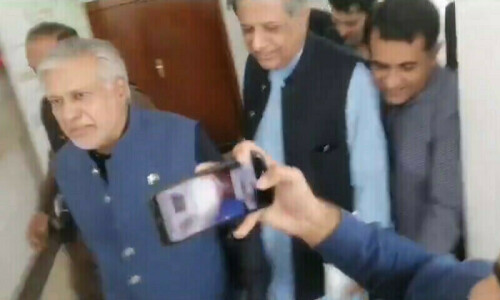KANDAHAR: For weeks now, the men in black turbans have been coming. They travel in pairs or small groups, on battered motorbikes or in dusty pickups, materialising out of the desert with Kalashnikovs and rocket launchers slung from their shoulders.
With the advent of warmer weather, villagers say, Taliban fighters are filtering back from their winter shelters in Pakistan, ensconcing themselves across Afghanistan’s wind-swept south.
”Everyday we see more and more of them,” said Abdul Karim, a farmer who already had sent his family away for safety.
The insurgents aren’t the only ones girding for battle.
At the country’s main Nato base outside Kandahar, nearly 2,300 US Marines have arrived over the past two months, their presence heralded by the thunder of transport aircraft and the springing up of a tent city built on a newly cleared minefield.
The Marine force’s final elements arrived days ago and began fanning out into the field, aiming to bolster British, Canadian and Dutch troops who until now have been bearing the brunt of fighting in Afghanistan’s south, considered the conflict’s strategic center.
The conflict in Afghanistan dominated discussions at last month’s Nato summit, where President Bush pledged to send more troops and pointedly urged allies to do likewise. Earlier this year, Defence Secretary Robert M. Gates heard urgent appeals for reinforcements from US commanders in Afghanistan, who forecast a substantial surge in fighting.
In Afghanistan, where presidential elections are due next year, opinion surveys consistently suggest that a majority of the population supports the presence of foreign forces. But people don’t want them to stay indefinitely.
The first-time arrival in Afghanistan’s south of a large force of Marines, the 24th Expeditionary Unit based in Camp Lejeune, N.C., has provided what commanders say is a much-needed infusion of firepower. The Marines have doubled the coalition’s air capacity; rows of Harrier jump jets, lumbering cargo planes and combat helicopters line the freshly laid tarmac.
Just as important, commanders say, the Marines’ deployment might give Nato-led troops the muscle and reach to choke off the flow of Taliban fighters and weaponry into neighboring Helmand province, consistently the most violence-racked in Afghanistan. It is the country’s epicenter of opium production and narco-trafficking, whose profits help fuel the insurgency.
In this unforgiving environment, British troops, considered to be among the alliance’s most effective fighters, have been forced to confine their efforts largely to the province’s northern tier, making Helmand, with its plethora of infiltration routes from Pakistan, a likely zone of deployment for the Marines.
Beaten badly in previous large-scale frontal assaults on Nato-led troops, Taliban fighters vow to harry them with more powerful and sophisticated roadside bombs, suicide attacks and methodical targeting of Afghans who are helping coalition forces.
Coalition commanders are well aware that the Taliban will try to steer the conflict toward hit-and-run strikes but say it is they, not the insurgents, who will seize the initiative.
”They definitely don’t want to go toe to- toe with us,” said Col Peter Petronzio, commander of the Marine expeditionary force operating out of the Kandahar base.
Many Taliban fighters are essentially part-timers; villagers say the ranks of locally-recruited insurgents will swell after the opium poppy crop has been planted.
And with fighting seemingly poised to escalate, one major worry for the coalition is civilian casualties, which spiked during combat last spring. At that time, human-rights groups charged that Western troops sometimes too readily called in airstrikes when under attack, obliterating village compounds that might not have contained only insurgents — if any.
Coalition commanders, in turn, have expressed frustration with what they describe as insurgents’ willful endangering of civilians by launching attacks from within their midst, combined with what they say is the common Taliban practice of reporting their own battle dead as civilians.
With harsh winter weather bringing a relative lull in fighting, the coalition has made a concerted effort to hunt down Taliban field commanders, either capturing them or killing them in pinpoint airstrikes. Senior Western military officials acknowledge, however, that in many cases, these leaders have been swiftly replaced, in some cases by younger and even more ruthless commanders.
”It’s a new generation we are seeing, capable of the worst kind of atrocities,” said Brig Gen Carlos Branco, spokesman of the Nato-led force.
Last week, insurgents slaughtered 17 Afghan road workers in neighboring Zabul province. In response, Afghan and coalition forces hunted down and killed two dozen Taliban blamed for the attack, military officials said this weekend.
Part of the Western alliance’s overall strategy is to turn more of the fighting and policing over to the Afghan security forces. American trainers believe they are turning a corner. Recruitment, pay and morale are up, they say. But although Afghan security forces have played a more prominent role in policing and battlefield engagements over the past year, serious problems remain.
For example, Afghan forces are used whenever possible for house searches, a culturally charged encounter that in the past has inflamed local resentment when carried out by foreign troops. However, commanders acknowledge that without careful monitoring, looting sometimes takes place during such Afghan-conducted searches.
Moreover, the Taliban find Afghan police a “softer” target than coalition troops and have killed scores in suicide strikes. Senior police officials say they believe the insurgents have marked them for death.
”The Taliban have warned me so many times to leave this job,” said Haji Saifullah, the district police commissioner in Maywand, a district of Kandahar province that borders Helmand and has become an insurgent stronghold. “They want to plant a roadside bomb, or send a suicide bomber, or shoot me. So far they haven’t succeeded.”
Longtime observers of the conflict say even if the insurgents’ strength is flagging, a protracted battle lies ahead.
”I think the Taliban are not as strong as in the past,” said Haji Dad Mohammad, a Kandahar-based former militia leader who has served as an intermediary between the government and insurgents. “But still, the fighting will go ahead.”—Dawn/The LAT-WP News Service(c) The Washington Post














































Dear visitor, the comments section is undergoing an overhaul and will return soon.